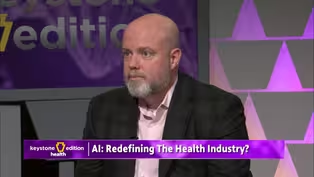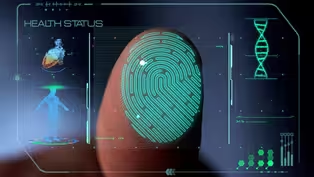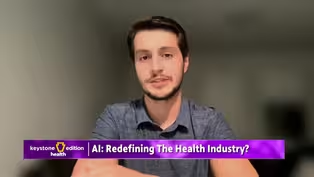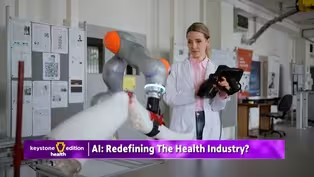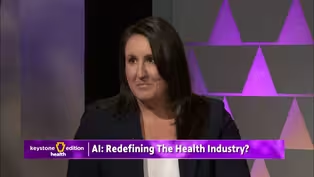Keystone Edition
AI: Redefining the Health Industry?
11/18/2024 | 27mVideo has Closed Captions
AI's integration into healthcare is set to usher in transformative changes
AI's integration into healthcare is set to usher in transformative changes, including the development of personalized treatment plans tailored to individual genetic profiles and lifestyles, and virtual health assistants available 24/7, providing real-time, accurate medical advice.
Problems playing video? | Closed Captioning Feedback
Problems playing video? | Closed Captioning Feedback
Keystone Edition is a local public television program presented by WVIA
Keystone Edition
AI: Redefining the Health Industry?
11/18/2024 | 27mVideo has Closed Captions
AI's integration into healthcare is set to usher in transformative changes, including the development of personalized treatment plans tailored to individual genetic profiles and lifestyles, and virtual health assistants available 24/7, providing real-time, accurate medical advice.
Problems playing video? | Closed Captioning Feedback
How to Watch Keystone Edition
Keystone Edition is available to stream on pbs.org and the free PBS App, available on iPhone, Apple TV, Android TV, Android smartphones, Amazon Fire TV, Amazon Fire Tablet, Roku, Samsung Smart TV, and Vizio.
Providing Support for PBS.org
Learn Moreabout PBS online sponsorship- [Presenter] Live from your public media studio's, WVIA Presents "Keystone Edition Health," a public affairs program that goes beyond the headlines to address issues in Northeastern and Central Pennsylvania.
This is "Keystone Edition Health."
And now moderator, Tonyehn Verkitus.
- Good evening, and welcome to "Keystone Edition Health."
I'm Tonyehn Verkitus.
Thank you for joining us tonight.
As medical professionals go through their career by making major decisions, AI is becoming a great ally for many of them by making more accurate answers and evaluating upon revolutionizing research.
Whether it is in robotic surgery or advanced diagnostic tools, AI assists in many different features with medical research and is pushing so many boundaries in healthcare.
But first, WVIA's Sarah Santo has more.
(logo whooshes) - [Sarah] Artificial intelligence is transforming the healthcare industry by enhancing diagnostic accuracy, personalizing treatment plans, and improving operational efficiency.
AI-powered tools can analyze medical imaging, predict patient outcomes, and assist in early detection of diseases such as cancer, heart conditions, and neurological disorders.
According to the National Library of Medicine, AI could significantly reduce inefficiency in healthcare, improve patient safety and overall experience, and help caregivers.
Machine learning algorithms process vast amounts of patient data to uncover patterns that may not be visible to human clinicians, enabling more precise and timely interventions.
As AI continues to evolve, it holds the potential to make healthcare more accessible, equitable, and efficient, leading to better patient outcomes, and revolutionizing the way we approach medical treatment.
For "Keystone Edition Health," I'm Sarah Santo, WVIA News.
(upbeat music) - Joining us tonight, we have Rebecca Stametz, vice president for digital transformation within the Steele Institute for Health Innovation at Geisinger, Dr. James Edward Murphy, orthopedic surgeon with Geisinger, and joining us remotely, we have Joe Fioti, co-founder and CTO of Dactyl.
Thank you all for joining us.
Rebecca, I'd actually like to kick it off with you.
Can you tell us a little bit about the background of Geisinger and its innovative ecosystem?
- Absolutely, but first I just wanna thank you for having two of us from Geisinger today.
It's a privilege to talk about emerging technologies and what we're doing to try to better the community and the health of our community.
Earlier this year, in 2024, Geisinger became the first member of Ryzen Health, which is a non-profit charitable organization, really geared to accelerate in the advancement of value-based care.
But Geisinger within the community has stood for over 100 years.
Back to 1915, I believe, we were developed by a philanthropist named Abigail Geisinger.
And since that time, we're across 126 care sites, and that includes 10 hospital campuses.
We also have a health plan that covers more than 500,000 lives that have commercial and government coverage.
What's interesting and really, I think, important for tonight's conversation is the rich history and reputation that we are very proud of when it comes to clinical innovation and learning.
We have a school of medicine health sciences, which helps to educate more than 5,000 health professionals a year, and we're rich deeply into the academics of producing research studies in the thousands as well.
Where I represent is the Innovation Institute in the organization, and we're very proud to work cross-functionally with multidisciplinary experts using human-centered approaches to advance the adoption, the implementation, sometimes the development of digital technologies, and in AI interventions to advance the safety, the efficacy, patient satisfaction, and in many cases, especially in 2024 and beyond, the satisfaction of our care teams.
- Joe, your company has actually used AI to help assist physicians in their day-to-day office work, right, the administrative part that becomes kind of burdensome at times.
Can you talk a little bit about, I guess, the apprehension around AI in healthcare?
'Cause I would imagine often patients are thinking, "Oh, who's taking my notes if it's not the doctor?"
- That's right, so a lot of the times what we see is that doctors, they're using various different strategies for doing note taking, but oftentimes it boils down to either A, they're memorizing everything that you say and then taking the notes later.
B, they're recording everything and sending it to somebody who's essentially on a Zoom call with you and taking the notes for the doctor.
Or C, they're taking the notes themselves while you're there.
And usually that's just a very bad experience, you know, so the doctors just typing away on their computer, and not even really looking at you, just sort of getting the information they need to take an accurate note.
What we saw though, as patients and as doctors, that this is a very burdensome process, both for the patient not being able to truly connect with their doctor and for the doctor themselves facing burnout from all of this time spent note taking.
So we endeavored to go apply machine learning to this because machine learning, speech recognition models were getting accurate enough now where they were starting to hit human levels of accuracy.
And so we took the best models that we can get and we just gave them to doctors and we said, you know what, let's try and use this and see if it actually is helpful, maybe it'll produce junk.
And it ended up producing the same level, if not better quality notes than they themselves could take, especially when they're trying to pay attention to the patient versus actually taking the note.
And originally what we did in order to make patients feel comfortable is give like a nice UI and just show that it's listening, the computer's listening.
That sort of didn't help the apprehension factor.
What we found best is if the doctor just uses our system on their smartphone and they just put it on the table, they don't even think about it, and they don't even...
It's the same experience as if the doctor was trying to memorize everything except the notes end up being far more accurate.
And we find that that provides a much more natural experience for the patient.
- And Jim, obviously you're not using AI, but you are using assistive technology.
One, can you tell us how long this has been in use at Geisinger, and what your relationship and experience has been?
- Yeah, absolutely, at Geisinger, we've had robotic technology in the operating room since about 2018, so about about six years.
We've been at the forefront of that, especially with hip and knee replacement, which is really where I think the benefit maximized.
You know, we've seen it develop even in this six-year period with increased software versions where, you know, it becomes more refined throughout the process.
So I think it's really helped us add precision to our operating room.
- Now, question, prior to robotic assistance, were surgeries longer, does this make the process quicker?
- So it can actually, okay.
You know, I think really where the value is when you have unique anatomy, right?
And I think that's the challenge is that we come in all different shapes and sizes, but our bones, we tend to think of them as the skeleton at Halloween.
But the truth is they're all shaped differently.
And that's where robotics really sees the advantage, when you have a unique anatomy that we may not see very often, the robotics can be very helpful with that.
- And Rebecca, how is AI being used in the hospital system?
- Yeah, when we think about AI, I mean there is a spectrum, right?
We think of artificial intelligence, but there's also other words associated with this advanced data science.
You might have heard of deep learning, you may have heard of machine learning, you may have recently, over the past year or so, we've heard in a lot of media outlets the term called generative AI, or the creation of something new, whether it's a document, a text, et cetera.
But when we think about AI in the healthcare system, I think, you know, we feel promise, that's what I'll say.
I'll say that especially at Geisinger, we are excited to explore the application to help us solve the biggest challenges of our time.
We also have to balance that with practicing responsible and ethical innovation, right?
And there's ways to do that, training, education, processes, policies.
But we've been doing this at Geisinger for some time.
I'm very privileged to work with many folks within the organization in the Innovation Institute and beyond, who wake up every day thinking about how to advance this type of skillset.
We do have an AI lab who have deep leaders and experience in this type of domain, who have applied interventions.
Now, those interventions at the core, though, are to try to increase safety, maybe increase early identification, or risk to a high burden disease, so to speak.
Or in many cases, similar to my panelist Joe, who was talking about administrative burden, how do you increase efficiencies?
So there's many, many use cases and examples, and this is really not new in the field, we're just seeing lightning speed advances as it relates to large language models and the advancement of generative AI.
So for an example, early detection, early identification, thinking of risk stratifications, we're all patients here on the panel, and we often are asked to get preventative screenings to take care of maybe cancers, or you know, a mammogram, a colonoscopy, these types of preventative screenings.
And we try to urge many patients to get those, but some don't, right?
We have the ability through machine learning and algorithms to identify people, patients, who are at really high risk of potentially having a complication.
So what we do is we use those risk stratifications and we create where I think the bread and the butter and the real value of these prediction models is the outreach.
How do we build this into the workflow?
So whether it's a nurse giving a patient a call or whether it's a nurse navigator, et cetera, we reach out to that patient and we kind of explain that they may be at higher risk, and we urge them to get that preventative type of screening.
So that's a real, very practical example of how we use advanced data science in order to help early detect high burden disease.
- Well, it seems like robotics would probably help with high risk, so to speak as well.
You were just talking about how people's anatomy can be different.
So I would assume that you don't have to cut into a person, open them up, and then see the issue.
Can you talk a little bit about how this can assist with high risk?
- Absolutely, and you know, that's the advantage of robotic surgery is that in order to use it, we do need a CT scan, which is a CAT scan.
It generates a three-dimensional model of your knee, and I'm literally able to put the implant on your knee prior to actually putting the implant on your knee.
So I think it's a huge advantage seeing how things fit, seeing how things can be twisted and tilted to make it balanced correctly, to make sure that everything is in the proper place it should be, without actually having to do any cutting at all.
It gives us an extra piece of armamentarium to make the surgery quicker, safer, and more predictable.
- Joe, you said earlier that the AI notes can sometimes be even better than the physician themselves or the person on Zoom.
Is there someone that's checking these notes and going back to make sure that it has the correct information?
- Absolutely, so like I said, the notes are often quality, and there's a number of reasons for that.
But what we've noticed is the main reason being that the doctor is able to focus more on the patient, and that means the doctor can ask better questions and catch things that they may have missed if they were focused on the note taking.
So, you know, a patient may make an offhand comment, and the doctor normally wouldn't pick up on that.
And yet that offhand comment might have contained something very important.
And so, you know, the notes end up actually being very detailed, but of course it's still a machine and it can still make mistakes.
And so at the end of the day, the doctor is still there to check over and verify that everything is accurate and ask any confirmation questions to the person while they're still there, the patient.
We have found though that the process of verification, it's so much faster than actually writing the note itself, and you end up with the same, if not better quality.
- How do you expect robotics to change?
What sorts of advancements do you see down the pipeline?
- So I think the biggest advancement actually will be with artificial intelligence as we continue to advance our planning.
You know, the robotics is really about the implementation of the plan.
And I think as artificial intelligence gets better, especially at predicting things that we don't see very often, unusual anatomy, I think that's really the exciting part for me, is using that planning phase, almost, you know, in a sense automatically knowing that the success rates will be predicted, you know, based on what we see from that CT scan, and then again using the robot to implement our plan.
- And in terms of... You talked about research before, are you also using AI to help with research per chance?
- I mean, I think it's an evolving field.
I think we obviously have a pretty broad interest in learning and evaluating these tools in a rigorous way.
When we think about the spectrum of AI and the types of toolkits our organization has across the innovation spectrum, whether that's intelligent automation, which is really a part of the AI spectrum, all the way to the generative AI that we're talking about regarding ambient documentation, the goal of all of those types of interventions is really geared toward making better health easy.
And that's better health easy for surgeons, for primary care, for our nurses, for our pharmacists, and for the folks who come in every day to help our organization run.
So when we think about the application of these smart tools, we're trying to grow our toolbox, right, and understand the types of challenges and apply the right intervention at the right time to solve for those.
But I think, the focus really, is about the operationalization of these types of smart tools and the adoption and the engagement, and really focusing on some of those hard outcomes.
So research, evaluation, rigorously taking a look at value metrics associated with the implementation is very focal to us.
- And Joe, how do you foresee things advancing for Dactyl?
Of course, you're pretty new company, you've started with this model.
What do you think you'll do in the future?
- So we've found a number of other orthogonal use cases for technology.
What we've noticed is that, you know, and once they actually have a full transcription of everything and they're working with the generated note, there's a number of other documents that they want to generate.
They may want to generate an invoice to insurance.
They may want to do medical coding, they may want to, as the exam is going on, pull from data from past exams, and get much more accurate diagnoses that way.
And so we've noticed that there is this really big advantage to having a historical look at a patient given all their past exams, their past scans, and then letting a doctor, on the fly, pull information from that.
And so we really see that this retrieval aspect holds a lot of opportunity.
- And let's go back to robotics for a second.
I think that people are thinking that it's probably kind of space age.
Can you talk us a little bit through what a surgery would look like when you're using robotics?
- Absolutely, so the robotics is mostly a robotic arm.
Now, we talked about the pre-op phase where we get the CT scan and we do the three dimensional planning, but the actual saw attaches to a robotic arm, and I guide the arm, right?
So unfortunately, I'm still necessary for a little while, but I do guide the arm based on our plan.
And what that does is keep me within about 1/2 a millimeter of tolerance of where I plan to do the cut.
So we still need to do the exposure, we still need to make sure all structures are safe, but the robot helps us keep stay within the boundaries of where we need to be without injuring any vital structures nearby, so it does make surgery safer.
- So if you're in 1/2 a millimeter now, what was it prior?
- Probably somewhere between 1 to 3.
- Okay.
- Yeah, yeah.
And it really, again, made challenging cases much more accessible to all surgeons.
You know, you didn't have to be in practice 15 years to do a really challenging case.
You can get that technology, use it, and then be able to help more people.
- What's the training like to use this assistive technology?
- To do robotics, so everyone must be certified, right?
So there is a course that all of us use for each individual platform of the robot, whether it's total knee, partial knee, or total hip.
And we have to do that under the supervision of the Mako company basically.
- So a question I have for whoever would like to answer this, obviously we're talking about AI, I feel like the first we started to hear about it was ChatGPT or something of that sort, and kids using it to write papers.
But really this has been around for while.
What are some examples that you could give for people so they understand they've been using this technology already?
I don't know if anyone has thoughts about that.
- I could say for the Mako robot, it's been in use probably since 2013.
- Okay.
- So it's been around even a lot longer than we have, and what we've seen as the applications continue to grow, the ability to use it in different areas in surgery will continue to grow, just even beyond knee and hip replacement.
So it has been around quite a while.
- Okay, and can you give us some scenarios of how AI has helped within the health system?
- Sure- - Through innovation.
- Absolutely, and sure, and just going back a bit around other types of maybe examples we have in our common lives.
Think about making a phone call and not maybe particularly speaking with a human being, but having the interaction to get a job done where it's self-service.
- Oh, like press one, press two.
(laughs) - Exactly, that's an example.
Another example is just interfacing with chatbots, that's a part of this AI spectrum I would say.
Those are common types of examples that we deal with in our everyday life.
And I'm not sure we think of that when we're interacting that as AI, so to speak.
But that is definitely learning and is definitely using data to advance self-service capabilities.
And really at the end of the day, again, going back to why we're doing this, is to enhance the self-service to get the job done maybe quicker, more efficiently, and maybe within the preferences that you want, right, so that's another example.
- Thank you.
Joe, how many physicians do you have using Dactyl right now?
I assume there might be other companies doing something similar.
So should we expect this to be become kind of the norm when we go to see our primary care physician?
- So in total, across the industry, I think we're, you know about, I saw somewhere, it's about like 20,000 physicians are using scribes like us.
For us personally, it's about a couple hundred, we're still a relatively young company.
But that sounds like a big number, a couple, you know, 20, 30,000, but we're still at, you know, about 1 or 2% total market penetration.
And so yeah, I think that this is gonna be a much more widespread thing, especially given the patient experience improvements that we've seen.
- And how do you see adaptation growing?
So are you seeing mostly younger physicians or older physicians using this too?
- Surprisingly, I think we've seen quite a bit of older physicians embrace this, especially because the younger ones already seem like they had a better setup with...
They have, you know, fancy systems on their computer where they're able to type out notes very quickly.
And usually the younger ones have that, and the older ones haven't really had the chance to set those things up yet, or the will to set those things up yet.
And so I think that the older ones have actually seen the most value out of this.
- And how long does it take to set up a system like this?
- For our system, about five minutes.
It depends exactly how deep you want to integrate it with your system.
We integrate with number of health record systems, and so some of that setup may take a few days on our end, but usually physicians can get set up and using it by just making account, and clicking the microphone, and starting to talk.
- So we talked earlier about how many surgeries you tend to do a day.
Do you feel that with the assistive technology you're doing more, or do you use that time to give the patient better quality care since you've kind of shortened things a little and can be more precise?
- Yeah, absolutely.
So it's a little of both, truthfully.
I think that's the advantage in the clinic.
You can spend more time with patients face to face, get more involved in their lives as well too.
You know, I think one of the things I enjoy doing is talking to patients, not just about their knees or hips, just about their life.
So I think that that helps with that, it helps with efficiency in the operating room as well, again, going down to being more precise, more predictable.
So I think yes, on both counts, yeah.
- Thank you.
We talked a little bit about ambient documentation.
Can you tell us a little bit more about that?
- Yeah, it's very similar to what Joe's speaking of, right?
It's, you know, I always take it a step back, right?
And not talking about the actual intervention, but why, right?
We have a workforce shortage, clinicians, nurses, et cetera.
And we're seeing the folks who care for the people who are our number one asset in the organization have burnout and experiencing administrative burden and demand.
So when we think about how we could apply more efficiency and decrease some of the administrative burden, we are piloting ambient documentation, which is a version of ambient listening and very much similar to what Joe was talking about.
So that's really focusing on how we could bring that type of value to the care team.
But I think it's also really important to understand that that patient experience and the type of time that that doctor is spending with the patient in the room is important as well.
So we're hoping to see a lot of patient satisfaction increase over this time as well.
So that's when we're thinking about ambient listening as a very broad umbrella, but that particular use case is what we're calling ambient documentation.
- Got it, got it.
Are you using this with your patients?
- I'm actually not yet.
(chuckles) I do have a lot of different tips and tricks that I use for myself in Epic, which is our main medical record generator.
So I've become pretty good at being able to get my notes done very quickly so that way I can spend the time talking to patients.
- Joe, you talked a little bit earlier about the fact that when these notes are being taken, there could be something that's scribed for the physician that they didn't pick up on before.
Can you give an example about how the technology would work, and maybe find that information for the physician later or highlighted in some way?
- Yeah, so the way our system works is, you know, over the duration of an exam, it is recording everything and then it is transcribing it in real time.
And so every word that the patient says and the doctors say, is transcribed down.
Afterwards, you know, the audio is immediately deleted, but we can keep that transcription around if the provider decides to, and every word, even offhand comments, can get picked up and then we flag them.
So we always have a model running that looks for important things that it might think are relevant to the diagnosis.
And again, you know, many, many words are said, you can have thousands and thousands of words spoken in a long visit, and being able to pick out precise phrases is a really important thing for these physicians.
- So I guess we won't be seeing AI go anywhere, and we can assume that there'll be more applications.
What are you hoping to see in the future, for instance?
- I think generally, we're very excited about the potential.
We're very excited about continuing to find use cases that are attaching to our main strategic priorities of the organization, and, you know, really trying to solve the most pressing challenges of our time within the healthcare organization.
We're proud of the way that our infrastructure is being set up and training and communication, and upskilling our employees in order to be able to kind of participate in that type of future.
I think you're gonna see AI kind of already on the healthcare system side, but also on the health plan side, on the contact center side, on ways that we could maybe predict or anticipate consumers expectations growing, whether it's self-service capabilities, or the ability to anticipate and provide quality.
So I could say that I'm very excited about the future.
- Thank you to all of our guests for their insights and to all of you for joining us.
For more information on tonight's episode and to see other episodes, go to wvia.org/keystonehealth.
For "Keystone Edition Health," I'm Tonyehn Verkitus, have a good evening.
(bright music)
Advancements in AI and Robotics in Healthcare
Video has Closed Captions
Clip: 11/18/2024 | 6m 46s | In this segment, panelists discuss advancements in AI and robotics in healthcare. (6m 46s)
AI: Redefining the Health Industry? - Preview
Preview: 11/18/2024 | 30s | Watch Monday, November 18th at 7pm on WVIA TV (30s)
The Future of AI in Healthcare
Video has Closed Captions
Clip: 11/18/2024 | 8m 31s | Future advancements aim to integrate AI further into healthcare, (8m 31s)
Overview - AI: Redefining the Health Industry
Clip: 11/18/2024 | 59s | AI is improving diagnostic accuracy, personalizing treatments, and enhancing operational efficiency. (59s)
Practical Applications for AI in Healthcare
Clip: 11/18/2024 | 8m 29s | A discussion of AI and Robotics in healthcare (8m 29s)
Providing Support for PBS.org
Learn Moreabout PBS online sponsorship
- News and Public Affairs

Top journalists deliver compelling original analysis of the hour's headlines.

- News and Public Affairs

FRONTLINE is investigative journalism that questions, explains and changes our world.












Support for PBS provided by:
Keystone Edition is a local public television program presented by WVIA
